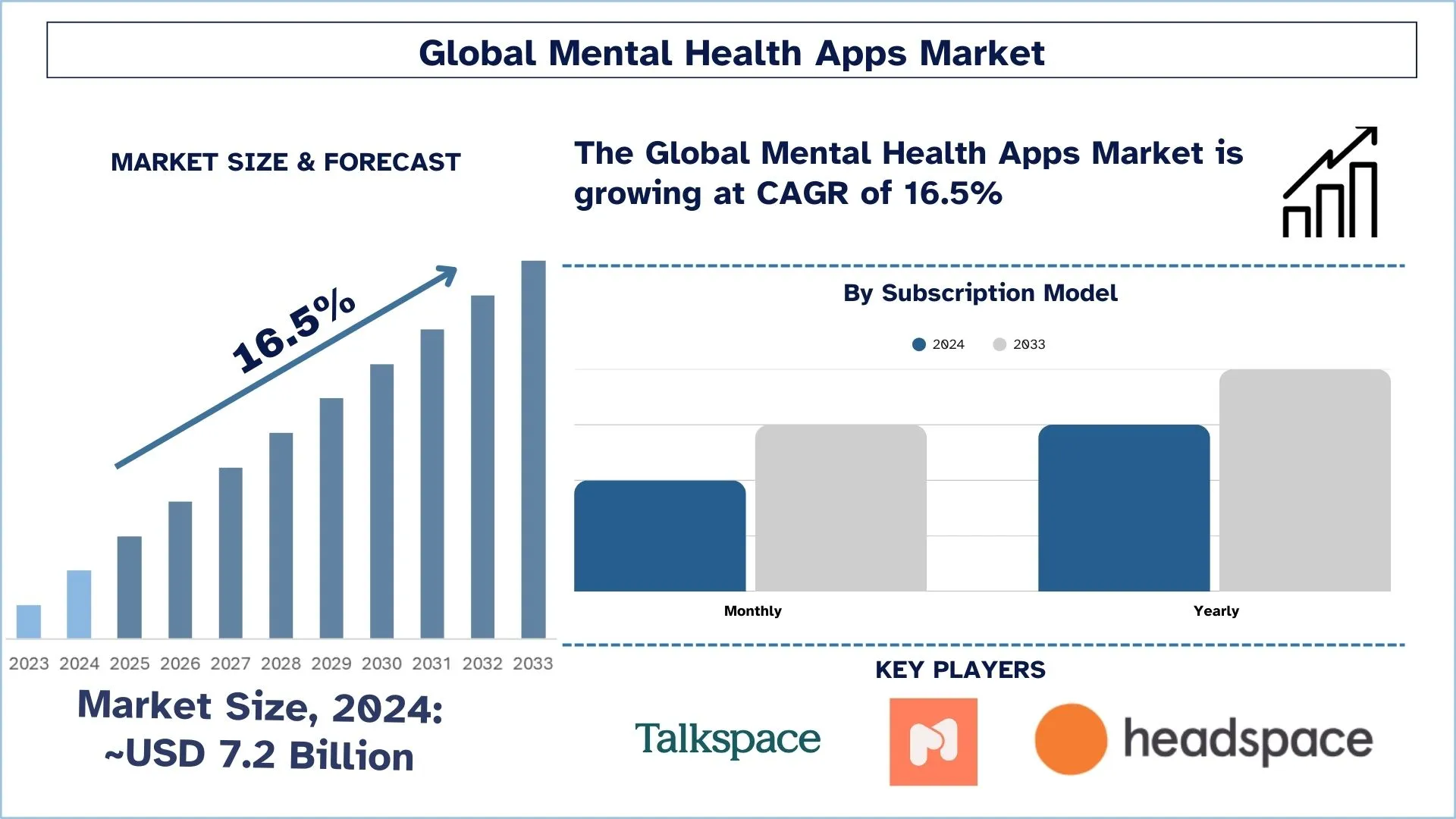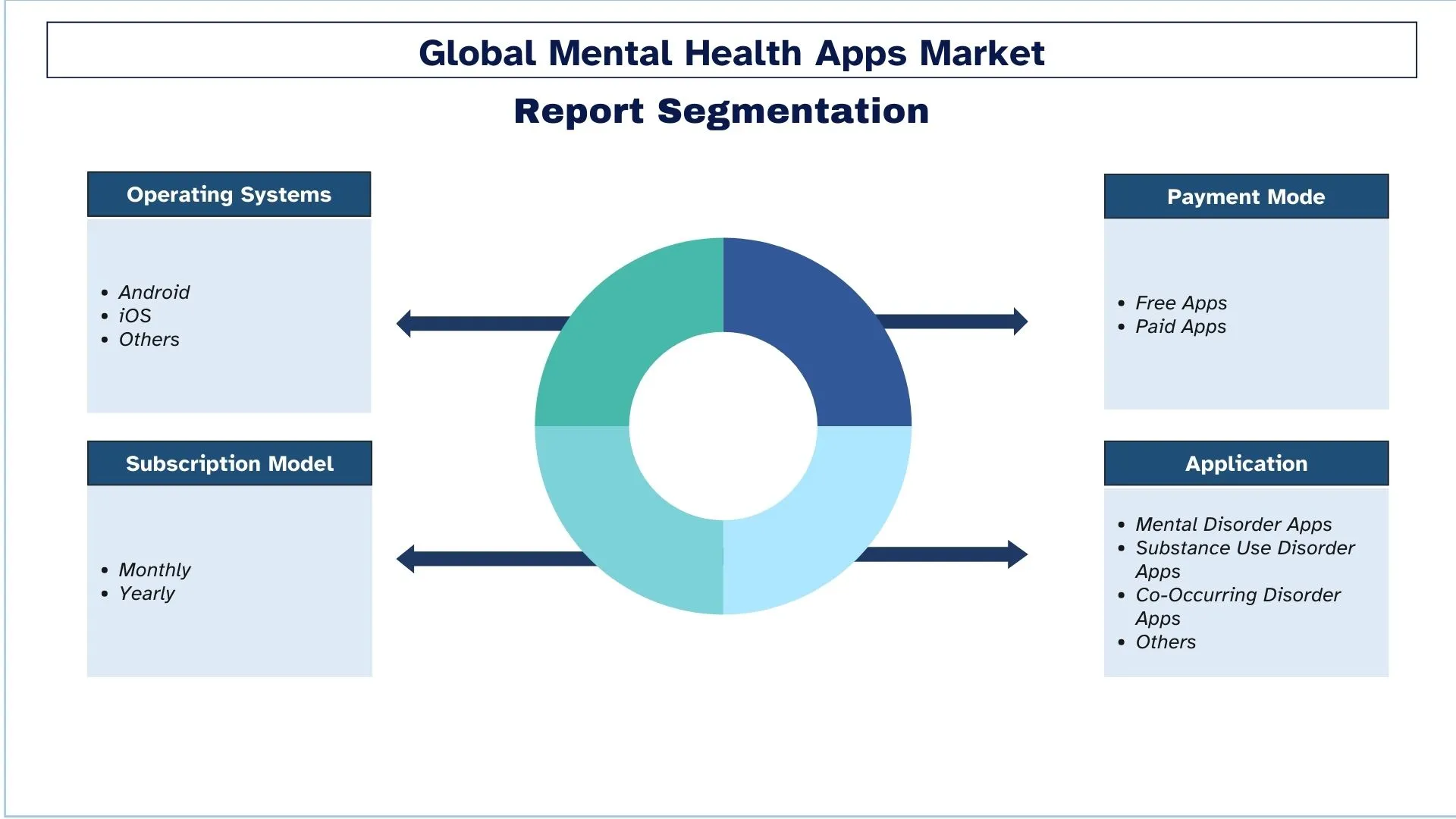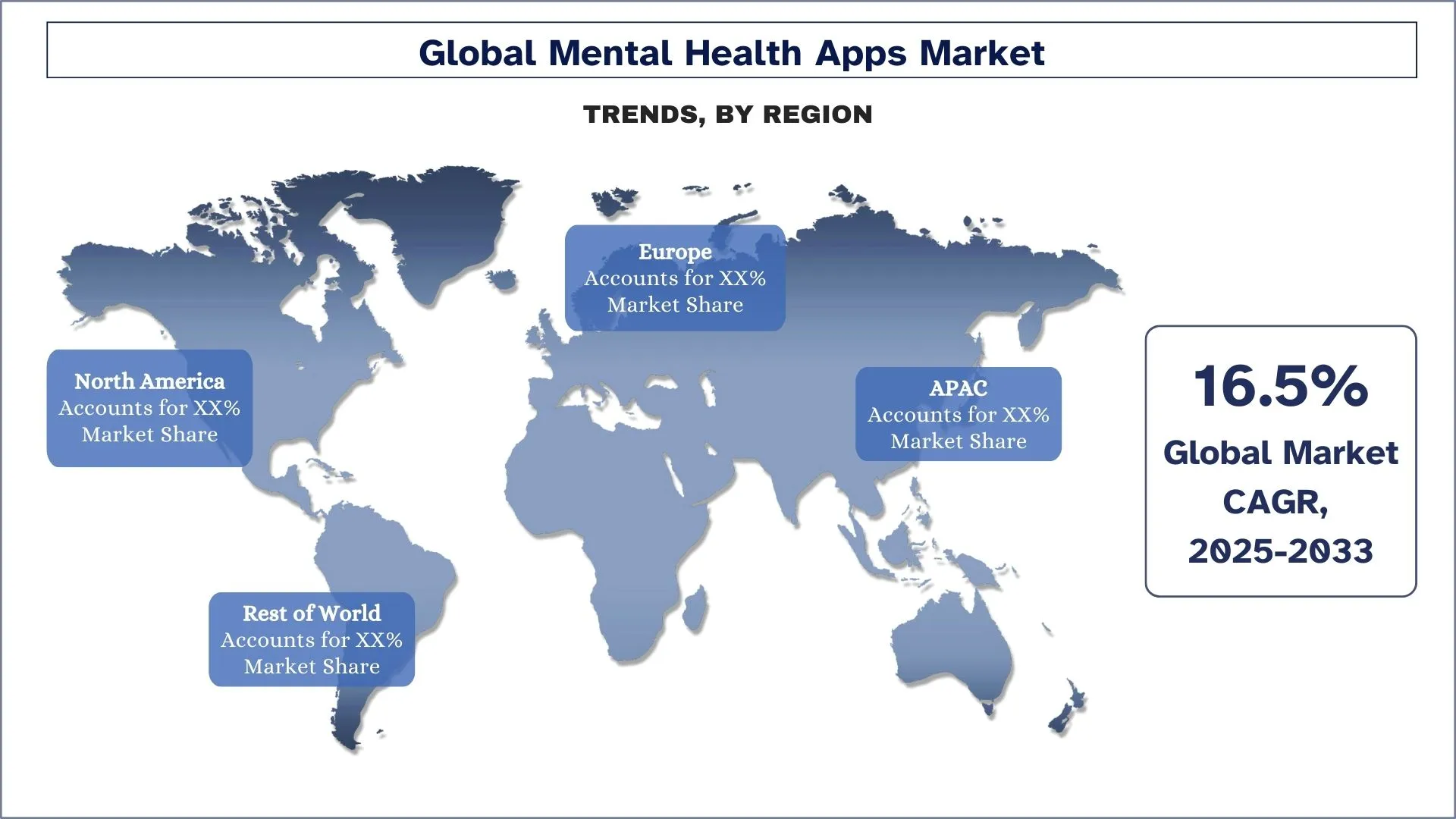- Home
- About Us
- Industry
- Services
- Reading
- Contact Us
Mental Health Apps Market: Current Analysis and Forecast (2025-2033)
Emphasis on Operating Systems (Android, iOS and Others); Payment Mode (Free Apps, Paid Apps); Subscription Model (Monthly, Yearly); Applications (Mental Disorder Apps, Substance-Use Disorder Apps, Co-Occurring Disorder Apps, Others) and Region & Country.

Mental Health Apps Market Size & Forecast
The Mental Health Apps Market was valued at approximately USD 7.2 billion in 2024 and is expected to grow at a substantial CAGR of around 16.5% during the forecast period (2025-2033), owing to the increased internet penetration and widespread adoption of smartphones.
Mental Health Apps Market Analysis
Mental health apps are applications created to help users maintain and enhance their mental health. Such apps offer features like mood monitoring, guided meditation, therapy, CBT, and self-help, among others. Some can be reached through mobile phones, and this has made it easier for people who feel this way to get the help they need, irrespective of the place they are stationed. The apps are typically developed to take on stress, anxiety, depression, and other related disorders, and to provide help at that level, or in cases where required, to refer the user to a professional.
The growth of mental health apps is due to a rise in the demand for solutions for mental health problems, which in turn is because of awareness about such problems being felt across the world. As per the World Health Organization, in 2022, 1 in every 8 people in the world lived with a mental disorder. Adding to this, the leaders of mental health app platforms try AI-driven individualization, incorporate teletherapy into their services, and actively develop cooperation with healthcare institutions to ensure growth. In April 2024, Fortis Healthcare introduced ‘Adayu Mindfulness,’ a new AI-driven application designed to help individuals dealing with mental health issues. They are concentrating on increasing customer loyalty by using analytics information, providing different subscription models, and addressing the issue of data protection. Moreover, it has been identified to be successful in the growth strategy is the involvement of employers and insurers in sponsoring mental health apps as part of the wellness programs offered at the workplace, while expanding the pool of consumers and enhancing their access, respectively.
Mental Health Apps Market Trends
This section discusses the key market trends influencing the various segments of the Mental Health Apps market as identified by our research experts.
Anxiety Transforms the Mental Health Apps Industry
As anxiety disorders are among the most prevalent mental health conditions in the world, the anxiety segment contributes to the market growth of mental health apps. As stress and anxiety disorders have become more common, beginning with the current lifestyle problems and further compounded by the COVID-19 outbreak, people also require practical and instant methods to alleviate these conditions. Mental health apps allow a user to undertake therapies such as CBT, mindfulness, or stress management exercises for those experiencing anxiety. Moreover, these apps also offer features such as mood tracking in real time, breathing exercises, as well as continued support, characteristics that are greatly valued by those who have anxiety. Increased consumer interest in personal wellness kits and the inclusion of anxiety applications as a part of organizational employee assistance programs have also pushed the segment forward and turned anxiety-centered mechanics into a growth driver for the entire industry.
Mental Health Apps Industry Segmentation
This section provides an analysis of the key trends in each segment of the global Mental Health Apps market report, along with forecasts at the global, regional, and country levels for 2025-2033.
The Android Operating System Segment Holds the Largest Share of the Mental Health Apps Market.
The Android operating system provides essential support to increase mental health app availability because it controls the international market and features broad accessibility. The domination of Android smartphones worldwide makes emerging markets such as India, Brazil, and Southeast Asia accessible to mental health app developers, whose target audience expands because of this market penetration. Thanks to its open-source structure, along with low device prices, the system makes itself available to diverse population segments, including individuals with limited financial resources and people living in rural areas. The flexible nature of mental health platforms allows them to create inexpensive solutions that match local behaviors and cultural norms, so the user base grows together with marketplace expansion.
The Mental Disorder Apps Market is Expected to Witness a Higher CAGR than the Mental Health Apps Market.
The market advances due to specific mental disorder apps which support depression, anxiety, bipolar disorder, PTSD, and OCD through personalized clinical support systems. People use these apps because they provide CBT tools alongside teletherapy and crisis intervention services, in addition to mood tracking capabilities, which meet the rising demand for stigma-free and on-demand mental healthcare services. These apps resolve the international surge in mental health problems through their scalable behavior, which supports individual care and collaboration with practitioners. The segment expansion is driven by these apps' ability to provide real-time data alongside evidence-based intervention services, which make them essential tools for both mental health professionals and patients.

North America has a significant share of the market in 2024.
North America holds the largest share of the market for mental health apps. According to NAMI.org, around 22.8% of U.S. adults experienced mental illness in 2021 (57.8 million people). This represents 1 in 5 adults. And around 47.2% of U.S. adults with mental illness received treatment in 2021. North America is one of the key contributors to the market for mental health apps because of the high rate of smartphone adoption, a continually rising concern for mental health, and rising interest in digital health solutions. The health system of the area is well developed, and the telehealth services adopted here are well accepted, which has led to the increased use of mental health apps. For instance, in October 2021, the United States Agency for International Development (USAID) and the Philippine Department of Health (DOH) launched Lusog-Isip – the country’s first mobile application for mental health and self-care. The enhancement in nowadays stress, anxiety, and depression in residents of the U.S. and especially young generations gives a strong demand to avail support tools for mental health.
U.S. Dominates the North American Mental Health Apps Market
The U.S. mental health apps market demonstrates robust development because people now recognize mental well-being and stress levels keep rising, plus society better accepts digital healthcare solutions. People with high technology proficiency and extensive smartphone use embrace mobile solutions to find on-demand help regarding anxiety treatments plus depression management, and stress reduction. The market receives support from healthcare policies, together with growing employer wellness initiatives and an increasing number of collaborations between application developers and healthcare providers. Mental health prioritization across the nation matches the U.S. lead position for adoption and innovation in this area.

Mental Health Apps Industry Competitive Landscape
The Mental Health Apps market is competitive, with several global and international players. The key players are adopting different growth strategies to enhance their market presence, such as partnerships, agreements, collaborations, new product launches, geographical expansions, and mergers and acquisitions.
Top Mental Health App Companies
Some of the major players operating in the market are Calm; Headspace Inc.; MindDoc Health GmbH (Schön Klinik); Talkspace; Moodfit; Happify, Inc., BetterHelp; SonderMind Inc.; NOCD Inc.; Youper Inc.
Recent Developments in the Mental Health Apps Market
In July 2024, LiftNow, a mental health mobile app designed to support children’s emotional wellness, was officially launched in India this week at Vels Vidyashram CBSE School, Pallavaram, Tamil Nadu. The Vels schools have an enrolment of more than 30,000 students. Preethaa Ganesh, Vice President of the Vels Group of Institutions, and Amairha Pokala, Founder of LiftNow India, unveiled the app.
In June 2024, Talkspace, a leading online behavioral health care company, announced it will join forces with FitOn, the No. 1 fitness app and digital health and wellness platform, to provide a holistic mental health and fitness solution to employers, and showcase the power of bringing together physical and mental fitness into an everyday setting.
In October 2022, Diageo, maker of Smirnoff, Gordon’s, and Guinness, became the first global FMCG company to launch the Unmind mental health app available to all employees worldwide. Coinciding with World Mental Health Day, Diageo’s 27,000 employees can now access the Unmind app through mobile and desktop devices.
Mental Health Apps Market Report Coverage
Report Attribute | Details |
Base year | 2024 |
Forecast period | 2025-2033 |
Growth momentum | Accelerate at a CAGR of 16.5% |
Market size 2024 | USD 7.2 Billion |
Regional analysis | North America, Europe, Asia-Pacific, Rest of the World |
Major contributing region | North America is expected to grow at the highest CAGR during the forecasted period. |
Key countries covered | U.S., Canada, Germany, France, UK, Spain, Italy, China, Japan, and India |
Companies profiled | Cloud Software Group, Inc.; Oracle; Health Catalyst; Verisk Analytics, Inc.; MCKESSON CORPORATION; SAS Institute Inc.; Allscripts Healthcare, LLC (Veradigm); Optum, Inc. (UnitedHealth Group); MedeAnalytics, Inc.; and IBM |
Report Scope | Market Trends, Drivers, and Restraints; Revenue Estimation and Forecast; Segmentation Analysis; Demand and Supply Side Analysis; Competitive Landscape; Company Profiling |
Segments Covered | By Application, By Mode of Delivery, By End-user, By Region/Country |
Reasons to Buy the Mental Health Apps Market Report:
The study includes market sizing and forecasting analysis validated by authenticated key industry experts.
The report presents a quick review of overall industry performance at a glance.
The report covers an in-depth analysis of prominent industry peers with a primary focus on key business financials, product portfolios, expansion strategies, and recent developments.
Detailed examination of drivers, restraints, key trends, and opportunities prevailing in the industry.
The study comprehensively covers the market across different segments.
Deep dive regional-level analysis of the industry.
Customization Options:
The global Mental Health Apps market can be customized further as per the requirement or any other market segment. Besides this, UnivDatos understands that you may have your own business needs; hence, feel free to contact us to get a report that completely suits your requirements.
Table of Content
Research Methodology for the Mental Health Apps Market Analysis (2023-2033)
We analyzed the historical market, estimated the current market, and forecasted the future market of the global Mental Health Apps market to assess its application in major regions worldwide. We conducted exhaustive secondary research to gather historical market data and estimate the current market size. To validate these insights, we carefully reviewed numerous findings and assumptions. Additionally, we conducted in-depth primary interviews with industry experts across the Mental Health Apps value chain. After validating market figures through these interviews, we used top-down and bottom-up approaches to forecast the overall market size. We then employed market breakdown and data triangulation methods to estimate and analyze the market size of industry segments and sub-segments.
Market Engineering
We employed data triangulation techniques to finalize the overall market estimation and derive precise statistical numbers for each segment and sub-segment of the global Mental Health Apps market. We split the data into several segments and sub-segments by analyzing various parameters and trends, including operating systems, payment mode, subscription model, applications, and regions within the global Mental Health Apps market.
The main objective of the Global Mental Health Apps Market Study is to
The study identifies current and future trends in the global Mental Health Apps market, providing strategic insights for investors. It highlights regional market attractiveness, enabling industry participants to tap into untapped markets and gain a first-mover advantage. Other quantitative goals of the studies include:
Market Size Analysis: Assess the current and forecast market size of the global Mental Health Apps market and its segments in terms of value (USD).
Mental Health Apps Market Segmentation: The study segments the market by operating systems, payment mode, subscription model, applications, and region.
Regulatory Framework & Value Chain Analysis: Examine the regulatory framework, value chain, customer behavior, and competitive landscape of the Mental Health Apps industry.
Regional Analysis: Conduct detailed regional analysis for key areas such as Asia Pacific, Europe, North America, and the Rest of the World.
Company Profiles & Growth Strategies: Company profiles of the Mental Health Apps market and the growth strategies adopted by the market leaders to sustain the fast-growing market.
Frequently Asked Questions FAQs
Q1: What is the mental health apps market's current size and growth potential?
The global Mental Health Apps market was valued at USD 7.2 billion in 2024 and is projected to expand at a CAGR of 16.5% from 2025 to 2033.
Q2: What are the driving factors for the growth of the Mental Health Apps market?
Increasing mental health awareness and demand for accessible, affordable care are driving the adoption of mobile apps offering therapy, self-help tools, and stress reduction programs on demand.
Q3: Which segment has the largest share of the Mental Health Apps market by application?
The Mental Disorder Apps Market currently holds the largest market share by application segment.
Q4: What are the major trends in the Mental Health Apps market?
Integration of AI and personalized content is reshaping mental health apps, enabling adaptive user experiences, real-time support, and more accurate tracking of emotional and behavioral patterns.
Q5: Which region will dominate the bone sonometer market?
North America leads the global Mental Health Apps market.
Q6: What are the biggest challenges in the Mental Health Apps market?
Data privacy concerns, especially regarding sensitive mental health information, and a lack of clinical validation for many apps hinder trust and broader adoption among users and healthcare providers.
Q7: Who are the Top players in the global Mental Health Apps market?
The leading companies driving innovation in Mental Health Apps include:
• Calm
• Headspace Inc.
• MindDoc Health GmbH (Schön Klinik)
• Talkspace
• Moodfit
• Happify, Inc.
• BetterHelp
• SonderMind Inc.
• NOCD Inc.
• Youper Inc.
Q8: What are the key investment opportunities in the mental health apps market?
Key investment areas include AI-driven personalization, digital therapeutics, B2B enterprise wellness platforms, and multilingual app expansion. These segments show high growth potential due to rising global demand for accessible mental healthcare.
Q9: How can companies differentiate themselves in the competitive mental health apps landscape?
Companies can gain a competitive edge by prioritizing clinical validation, securing regulatory approvals, integrating with telehealth services, offering data-driven insights, and delivering user-centric, personalized mental health experiences.
Related Reports
Customers who bought this item also bought










